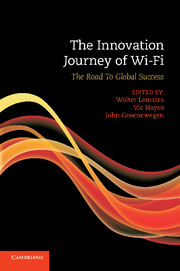Book contents
- Frontmatter
- Contents
- Figures
- Tables
- Contributors
- Preface
- Introduction
- 1 The case and the theoretical framework
- Part 1 The Wi-Fi Journey
- 2 NCR: taking the cue provided by the FCC
- 3 Creating a wireless LAN standard: IEEE 802.11
- 4 Crossing the chasm: the Apple AirPort
- 5 Hotspots: the Starbucks initiative
- 6 Wi-Fi-based community networks: Wireless Leiden
- Part 2 The Wi-Fi Journey in Perspective
- Part 3 Annexes
- Index
- References
4 - Crossing the chasm: the Apple AirPort
Published online by Cambridge University Press: 05 June 2012
- Frontmatter
- Contents
- Figures
- Tables
- Contributors
- Preface
- Introduction
- 1 The case and the theoretical framework
- Part 1 The Wi-Fi Journey
- 2 NCR: taking the cue provided by the FCC
- 3 Creating a wireless LAN standard: IEEE 802.11
- 4 Crossing the chasm: the Apple AirPort
- 5 Hotspots: the Starbucks initiative
- 6 Wi-Fi-based community networks: Wireless Leiden
- Part 2 The Wi-Fi Journey in Perspective
- Part 3 Annexes
- Index
- References
Summary
Crossing the chasm
‘Changing the rules rarely happens overnight’ is a characterisation that certainly applies to NCR and the Wi-Fi journey; or, in the words of Martin Bradley, general manager at NCR: ‘Bringing new technologies to market takes time, and, whatever time in your estimate it will take, it will take longer.’ Although the value aspect of deploying a wireless LAN appears an attractive enough proposition – obviating the need for the expensive cabling systems required for a wired LAN – the initial sales efforts showed that the introduction of the new technology was not the smooth ride suggested by the stylised technology adoption curves presented in marketing textbooks.
In this respect, Moore (1991) points to the difference in the process between continuous and discontinuous innovations. Continuous innovations are often incremental and do not require consumers to change their habits. Discontinuous innovations, on the other hand, demand significant changes not only on the part of the consumer but also in the related infrastructure. While recognising that companies have the objective of subsequently capturing each group of buyers, from the early adopters to the laggards, Moore emphasises the differences between five buyer groups and companies’ need to adjust their marketing and sales effort to each group. The alternative is that they ‘lose momentum, [and] miss the transition to the next segment, thereby never to gain the promised land of profit-margin leadership in the middle of the bell curve’ (Moore, 1991).
- Type
- Chapter
- Information
- The Innovation Journey of Wi-FiThe Road to Global Success, pp. 110 - 153Publisher: Cambridge University PressPrint publication year: 2010
References
- 1
- Cited by



